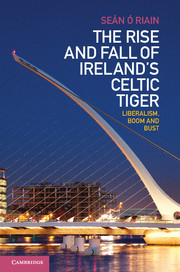Book contents
- Frontmatter
- Contents
- List of figures
- List of tables
- Acknowledgements
- 1 Liberalism in crisis
- 2 Ireland: between development and crisis
- 3 Capital: the triumph of finance*
- 4 Europe: between market and diversity
- 5 National politics: governing fragmentation, fragmented governance
- 6 Crisis: the difficult politics of development and liberalism
- Bibliography
- Index
4 - Europe: between market and diversity
Published online by Cambridge University Press: 05 June 2014
- Frontmatter
- Contents
- List of figures
- List of tables
- Acknowledgements
- 1 Liberalism in crisis
- 2 Ireland: between development and crisis
- 3 Capital: the triumph of finance*
- 4 Europe: between market and diversity
- 5 National politics: governing fragmentation, fragmented governance
- 6 Crisis: the difficult politics of development and liberalism
- Bibliography
- Index
Summary
Introduction
The Irish banking crisis was produced at a variety of levels. Most narrowly, it was a local crisis, produced primarily by Irish banks and developers who were largely oriented towards the domestic economy. Most broadly, it was one case of a broader crisis of economic liberalism. Many of the conditions that made the local crisis possible were intrinsic elements of market liberalism – the limiting of public regulation and the rejection of political guidance of the economy, the weaknesses of private regulation in securing the common good, and the structural importance and discursive privileging of markets and particularly finance.
The previous chapter touched on a further crucial element in the Irish crisis that links these specific and universal features of crisis together. These are the transnational organisational and institutional connections that translated the local and global features of the crisis into one another. Most crucial in the Irish case were the set of connections that allowed Irish banks to raise massive amounts of funding internationally from 2001 to 2007, the period in which the property bubble was largely funded from external funds channelled through the main Irish banks. The role of the credit rating agencies in making this relationship possible has already been discussed both in terms of their role in making bubble-era development loans into ‘investable’ or increasingly ‘liquid’ entities and their own reliance on broad assumptions about market efficiencies to underpin their judgments. More broadly, these agencies were important in the connection they made possible between the Irish banking and property-based growth machine and the broader regional processes of financialisation and Europeanisation.
- Type
- Chapter
- Information
- The Rise and Fall of Ireland's Celtic TigerLiberalism, Boom and Bust, pp. 114 - 167Publisher: Cambridge University PressPrint publication year: 2014



